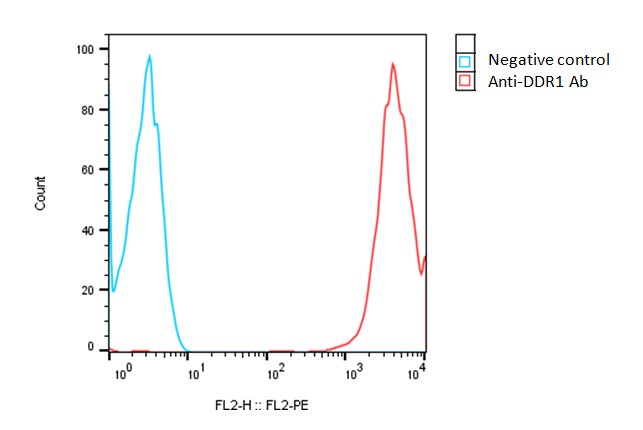
| Catalog Number | Product | Size | Price | |
|---|---|---|---|---|
| C3081 | Human DDR1-CHO-K1 stable cell line | 2 vials | $6000 | Order |
| Catalog Number | C3081 |
|---|---|
| Cell Line Name | Human DDR1-CHO-K1 Stable Cell Line |
| Accession Number | Full-length human DDR1 (NM_001954.5) |
| Host Cell | Adherent CHO-K1 |
| Quantity | Two vials of frozen cells (3x106 per vial) |
| Culture Medium | DMEM with 10% FBS, 4 ug/ml puromycin |
| Freezing Medium | 90% FBS and 10% DMSO |
| Storage | Liquid nitrogen upon receipt |
| Product Datasheet: | Download PDF |
Detection of human DDR1 expression on CHO-K1 cells using a mouse anti-human anti-DDR1 monoclonal antibody, followed by staining with a PE-anti-mouse IgG antibody. The cells that are stained only with PE-anti-mouse IgG antibody are used as a negative control.

DDR1 (discoidin domain receptor tyrosine kinase 1), also known as CD167, CAK, DDR, NEP, HGK2, PTK3, RTK6, TRKE, EDDR1, MCK10, NTRK4, and PTK3A,is a receptor tyrosine kinase (RTK) and belongs to a subfamily of tyrosine kinase receptors with a homology region to the Dictyosteliumdiscoideum protein discoidin I in its extracellular domain. DDR1 consists of three regions (an extracellular ligand binding domain, a transmembrane domain, and an intracellular region containing a kinase domain), with its kinase activity induced by receptor-specific ligand binding. Collagen binding to DDR1 stimulates its autophosphorylation, activating kinase activity and signaling to downstream signaling pathways. DDR1 expression is restricted to epithelial cells, particularly in the kidney, lung, gastrointestinal tract, and brain and is significantly over-expressed in several human tumors from breast, ovarian, esophageal, and brain. DDR1 plays a key role in the development and progression of breast and ovarian cancer and is a promising therapeutic target.
Johnson, J. D., Edman, J. C., Rutter, W. J., Proc. Nat. Acad. Sci. 90: 5677-5681, 1993.
Chen, L., et al, Frontiers in Cell and Dev. Bio. 747314, 2021
Letinger, B., Int Rev Cell Mol Biol. 310: 39-87, 2014
Vogel, W., et al., Mol. Cell. 1: 13–23, 1997